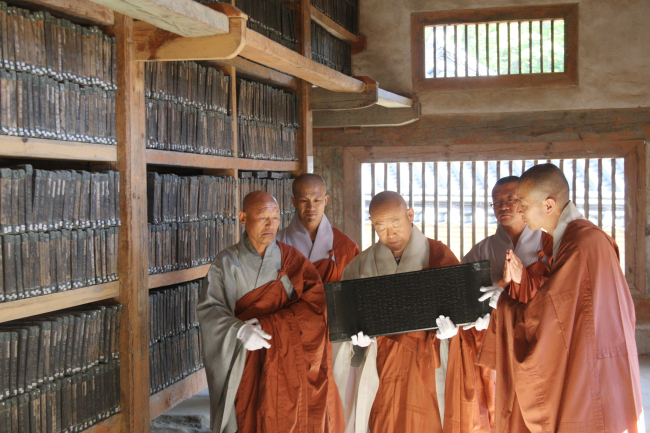Bas relief statue of Buddha, Tripitaka Koreana blocks shown to the public
Unveilings mark celebration of the opening of Tripitaka Koreana Festival on Friday
By Korea HeraldPublished : Sept. 25, 2013 - 20:38
HAPCHEON, South Gyeongsang Province ― The smile of Buddha on a rock cliff in Mount Gayasan in South Gyeongsang Province opened to the public on Wednesday, the first time in 1,200 years.
The “Maaebul,” a 7.5-meter-tall Buddha image carved into a large granite boulder, is situated about 2.7 kilometers from Haeinsa Temple in Hapcheon, South Gyeongsang Province, and has been used as a prayer site among monks since its creation during the Silla Kingdom (B.C. 57-A.D. 935).
According to Buddhist art tradition, Buddha, with both of his shoulders covered in cloth and his hand gestures describing his teaching to the lowest people in the world, delivers a strong message that Buddha of the highest and noblest status is here for the most common people.
“The late Silla era was full of violence and invasions. The statue is seen to have reflected people’s desire for peace and solace,” said Ven. Jonggo of the temple.
The trail leading to the sculpture, which is in the middle of the steep, rocky mountain, has been cleared for easier public access.
The “Maaebul,” a 7.5-meter-tall Buddha image carved into a large granite boulder, is situated about 2.7 kilometers from Haeinsa Temple in Hapcheon, South Gyeongsang Province, and has been used as a prayer site among monks since its creation during the Silla Kingdom (B.C. 57-A.D. 935).
According to Buddhist art tradition, Buddha, with both of his shoulders covered in cloth and his hand gestures describing his teaching to the lowest people in the world, delivers a strong message that Buddha of the highest and noblest status is here for the most common people.
“The late Silla era was full of violence and invasions. The statue is seen to have reflected people’s desire for peace and solace,” said Ven. Jonggo of the temple.
The trail leading to the sculpture, which is in the middle of the steep, rocky mountain, has been cleared for easier public access.

Meanwhile, eight blocks of the Tripitaka Koreana, or “Palmandaejangyeong (80,000 canons),” one of the most famous Buddhist canons in the world, were also shown to the public on the day to mark the 2013 Tripitaka Koreana Festival that kicks off on Friday.
The Tripitaka Koreana, consisting of some 1,514 texts carved on 81,258 individual wooden blocks and bundled into 6,815 fascicles, is thought to have been created in the 13th century in hopes of warding off a Mongol invasion of the peninsula. The wooden blocks are rarely put on public display.
Ranking officials of Haeinsa Temple as the Jogye Order, of which the temple is a member, attended a ceremony moving the wooden printing blocks to the Tripitaka Theme Park located about 7 kilometers away from the temple. A traditional Korean band dressed in traditional costumes performed folk songs such as “Arirang” and “Pungnyeoniwatne (Wishing for full harvest)” while monks carrying a delicately decorated palanquin holding the canons moved slowly to the festival venue. Scores of volunteers followed the palanquin.
This is the second time the canons have been shown to the public following the Tripitaka Koreana 2011 festival. “Very few people have managed to see both treasures even inside the Buddhist circle. The unveiling was a big decision for us but we are hoping that the festival will bring people closer to Buddhism,” a monk at Haeinsa Temple, where the canons are stored, said before the removal of the canons.
By Bae Ji-sook (baejisook@heraldcorp.com)
The Tripitaka Koreana, consisting of some 1,514 texts carved on 81,258 individual wooden blocks and bundled into 6,815 fascicles, is thought to have been created in the 13th century in hopes of warding off a Mongol invasion of the peninsula. The wooden blocks are rarely put on public display.
Ranking officials of Haeinsa Temple as the Jogye Order, of which the temple is a member, attended a ceremony moving the wooden printing blocks to the Tripitaka Theme Park located about 7 kilometers away from the temple. A traditional Korean band dressed in traditional costumes performed folk songs such as “Arirang” and “Pungnyeoniwatne (Wishing for full harvest)” while monks carrying a delicately decorated palanquin holding the canons moved slowly to the festival venue. Scores of volunteers followed the palanquin.
This is the second time the canons have been shown to the public following the Tripitaka Koreana 2011 festival. “Very few people have managed to see both treasures even inside the Buddhist circle. The unveiling was a big decision for us but we are hoping that the festival will bring people closer to Buddhism,” a monk at Haeinsa Temple, where the canons are stored, said before the removal of the canons.
By Bae Ji-sook (baejisook@heraldcorp.com)
-
Articles by Korea Herald




















